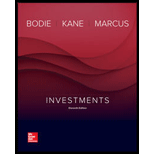
Investments
11th Edition
ISBN: 9781259277177
Author: Zvi Bodie Professor, Alex Kane, Alan J. Marcus Professor
Publisher: McGraw-Hill Education
expand_more
expand_more
format_list_bulleted
Question
Chapter 7, Problem 20PS
Summary Introduction
To compute: Annual
Introduction: An investor may invest in various stocks to reduce the risk of losses. Such a theory is called correlation theory. It is believed that an investor takes a lot of risk to achieve higher
Expert Solution & Answer
Want to see the full answer?
Check out a sample textbook solution
Students have asked these similar questions
Calculate dividend using appro
What is the primary function of insurance?
explain
Dont use ai and sopve this
Chapter 7 Solutions
Investments
Ch. 7 - Prob. 1PSCh. 7 - Prob. 2PSCh. 7 - Prob. 3PSCh. 7 - Prob. 4PSCh. 7 - Prob. 5PSCh. 7 - Prob. 6PSCh. 7 - Prob. 7PSCh. 7 - Prob. 8PSCh. 7 - Prob. 9PSCh. 7 - Prob. 10PS
Ch. 7 - Prob. 11PSCh. 7 - Prob. 12PSCh. 7 - Prob. 13PSCh. 7 - Prob. 14PSCh. 7 - Prob. 15PSCh. 7 - Prob. 16PSCh. 7 - Prob. 17PSCh. 7 - Prob. 18PSCh. 7 - Prob. 19PSCh. 7 - Prob. 20PSCh. 7 - Prob. 21PSCh. 7 - Prob. 22PSCh. 7 - Prob. 23PSCh. 7 - Prob. 1CPCh. 7 - Prob. 2CPCh. 7 - Prob. 3CPCh. 7 - Prob. 4CPCh. 7 - Prob. 5CPCh. 7 - Prob. 6CPCh. 7 - Prob. 7CPCh. 7 - Prob. 8CPCh. 7 - Prob. 9CPCh. 7 - Prob. 10CPCh. 7 - Prob. 11CPCh. 7 - Prob. 12CPCh. 7 - Prob. 13CP
Knowledge Booster
Similar questions
- solve this question.Pat and Chris have identical interest-bearing bank accounts that pay them $15 interest per year. Pat leaves the $15 in the account each year, while Chris takes the $15 home to a jar and never spends any of it. After five years, who has more money?arrow_forwardWhat is corporate finance? explain all thingsarrow_forwardSolve this finance problem.arrow_forward
arrow_back_ios
SEE MORE QUESTIONS
arrow_forward_ios
Recommended textbooks for you
 Essentials of Business Analytics (MindTap Course ...StatisticsISBN:9781305627734Author:Jeffrey D. Camm, James J. Cochran, Michael J. Fry, Jeffrey W. Ohlmann, David R. AndersonPublisher:Cengage Learning
Essentials of Business Analytics (MindTap Course ...StatisticsISBN:9781305627734Author:Jeffrey D. Camm, James J. Cochran, Michael J. Fry, Jeffrey W. Ohlmann, David R. AndersonPublisher:Cengage Learning Intermediate Financial Management (MindTap Course...FinanceISBN:9781337395083Author:Eugene F. Brigham, Phillip R. DavesPublisher:Cengage Learning
Intermediate Financial Management (MindTap Course...FinanceISBN:9781337395083Author:Eugene F. Brigham, Phillip R. DavesPublisher:Cengage Learning

Essentials of Business Analytics (MindTap Course ...
Statistics
ISBN:9781305627734
Author:Jeffrey D. Camm, James J. Cochran, Michael J. Fry, Jeffrey W. Ohlmann, David R. Anderson
Publisher:Cengage Learning

Intermediate Financial Management (MindTap Course...
Finance
ISBN:9781337395083
Author:Eugene F. Brigham, Phillip R. Daves
Publisher:Cengage Learning
